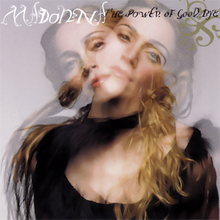
Richard Wright Nowels Jr. is an American songwriter, record producer, multi-instrumentalist and arranger. He has co-written and co-produced over 90 hit singles with multiple artists and albums his songs have appeared on have sold over 250 million copies. In 2020, he was inducted into the Songwriters Hall of Fame.
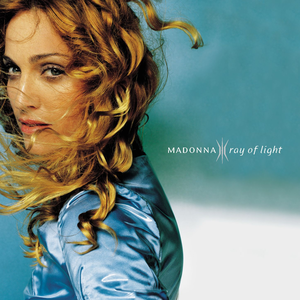
Ray of Light is the seventh studio album by American singer-songwriter Madonna, released in early 1998 by Maverick Records. A major stylistic and aesthetic departure from her previous work, Bedtime Stories, Ray of Light is an electronica and techno-pop record which incorporates multiple genres, including ambient, trip hop, psychedelic music and Middle Eastern music, while also seeing Madonna singing with greater breadth and a fuller tone. Mystical themes are also strongly present in both the music and lyrics, as a result of Madonna embracing Kabbalah, her study of Hinduism and Buddhism, and her daily practice of Ashtanga yoga.

"Frozen" is a song by American singer and songwriter Madonna from her seventh studio album, Ray of Light (1998). Maverick and Warner Bros. Records released it as the album's lead single on January 23, 1998. The song was also included on the compilation albums, GHV2 (2001) and Celebration (2009). "Frozen" was written by Madonna and Patrick Leonard, who both produced it in collaboration with William Orbit. The downtempo electronica ballad, which has a layered sound enhanced by synthesizers and strings, lyrically addresses a cold and emotionless man.

"Gettin' Jiggy wit It" is a song by American rapper and actor Will Smith, released as the third single from his debut solo album, Big Willie Style (1997). The verse is based around a sample of "He's the Greatest Dancer" by Sister Sledge, and the chorus is sampled from "Sang and Dance" by the Bar-Kays. Released in early 1998, the song was Smith's second hit produced by Poke & Tone and L.E.S., who replaced his long-time partner Jazzy Jeff, though the record-scratching techniques of Jazzy Jeff can be heard in the song.

"Music" is a song recorded by American singer Madonna as the title track for her eighth studio album of the same name (2000). It was released as the lead single from the album to radio on August 1, 2000, by Maverick and Warner Bros. Records and commercially released on August 21. "Music" was inspired by a Sting concert Madonna attended and was written and produced by her with Mirwais Ahmadzaï. It is a disco, electro-funk and dance-pop song in a static key of G minor. Madonna's vocals are electronically manipulated in the track, with the lyrics having political and social undertones and reiterating the uniting power of music.

"Beautiful Stranger" is a song by American singer and songwriter Madonna. It was released on May 19, 1999, by Maverick and Warner Bros. Records as a single from the soundtrack of the film, Austin Powers: The Spy Who Shagged Me. Madonna co-wrote and co-produced the song with William Orbit. The soundtrack for Austin Powers: The Spy Who Shagged Me was a much expected release and Madonna's song was chosen by the album's executive producers to promote it. "Beautiful Stranger" has appeared on three separate Madonna greatest hits collections: GHV2 (2001), Celebration (2009) and Finally Enough Love: 50 Number Ones (2022). Musically, "Beautiful Stranger" is a psychedelic pop and disco song that features heavily reverberated guitars and bouncy drum loops. Its lyrics tell the tale of a romantic infatuation.

"Nothing Really Matters" is a song by American singer Madonna for her seventh studio album, Ray of Light (1998). It was written by Madonna and Patrick Leonard, and was produced by the singer with William Orbit and Marius De Vries. The song was released as the sixth and final single from the album on February 9, 1999, by Maverick Records and Warner Bros. Records. An electronic dance track on which Madonna experiments with different musical genres, "Nothing Really Matters" includes ambient music and electronic noise frequencies that were added by De Vries. Lyrically, the recording delves on the singer's first daughter Lourdes Leon, having also themes of selfishness, affection, and motherhood.

"Drowned World/Substitute for Love" is a song recorded by American singer Madonna for her seventh studio album, Ray of Light (1998). It was written and produced by Madonna and William Orbit, with additional songwriters including Rod McKuen, Anita Kerr and David Collins. McKuen and Kerr received the credits due to the usage of a sample from one of their songs, "Why I Follow the Tigers". "Drowned World/Substitute for Love" is an ambient pop song which lyrically describes Madonna's spiritual transformation to seek authentic love over superficial alliances.

"Ray of Light" is a song by American singer Madonna. It is the title track from her seventh studio album, Ray of Light (1998), and was released as the album's second single on April 27, 1998, by Maverick Records. The song was also included on the compilation albums GHV2 (2001) and Celebration (2009). Written by Madonna, William Orbit, Clive Maldoon, Dave Curtiss, Christine Leach, and produced by Madonna and Orbit, "Ray of Light" is based on Curtiss Maldoon's "Sepheryn" and is an electronic dance song with techno, trance, Eurodance, and disco influences. "Ray of Light" consists of a main synth sound oscillating on the primary musical note and an electric guitar riff. Lyrically, the song has a theme of freedom.

"Causing a Commotion" is a song by American singer Madonna from the soundtrack album to the 1987 film Who's That Girl. It was released as the album's second single on August 25, 1987, by Sire Records. Its Silver Screen Single Mix later appeared on the EP The Holiday Collection (1991). Written and produced by Madonna and Stephen Bray, the song was inspired by her relationship with then-husband Sean Penn, and his abusive and violent nature. Containing a dance-oriented, up-tempo groove, the song begins with the chorus and is accompanied by a four-note descending bassline and staccato chords in the verses.

"Crazy for You" is a song recorded by American singer Madonna for the film Vision Quest (1985). It was released on March 2, 1985 by Geffen Records as the lead single from the film's soundtrack album. Film producers Jon Peters and Peter Guber, along with music director Phil Ramone, decided to use Madonna after listening to her previous recordings, employing John Bettis and Jon Lind to write the song. After reading the script of the film, Bettis and Lind wrote the song about the situation in which the lead characters meet at a nightclub. Initial recording sessions did not impress Bettis and Lind, and they felt that "Crazy for You" would be dropped from the soundtrack. However, a new version was recorded to their liking.
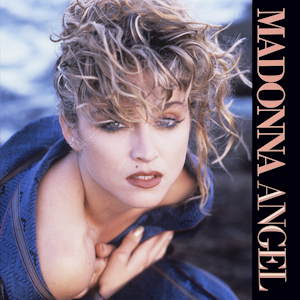
"Angel" is a song by American singer Madonna from her second studio album Like a Virgin (1984). It was released on April 10, 1985, by Sire Records as the album's third single. Written by Madonna and Steve Bray, it was one of the first songs developed for the project and, according to Madonna, was inspired by a girl who is saved by an angel, and she falls in love with him. "Angel" was released as a 12-inch single with "Into the Groove" in some countries and charted likewise. A music video was not filmed for "Angel", and instead, a promotional clip comprising segments of her previous videos was released in the United Kingdom.
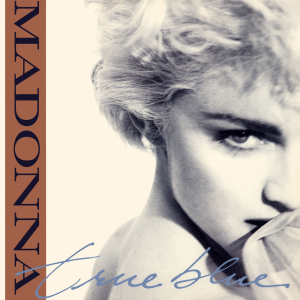
"True Blue" is a song by American singer Madonna from her third studio album of the same name (1986), released as the third single on September 10, 1986, by Sire Records. Written and produced by Madonna and Steve Bray, the song deals with Madonna's feelings for her then-husband Sean Penn. A dance-pop song, it features instrumentation from a rhythm guitar, a synthesizer, keyboards, and drums. The main chorus is backed by an alternate one, incorporating a chord progression generally found in doo-wop music.

"Rescue Me" is a song by American singer Madonna from her first greatest hits album, The Immaculate Collection (1990). Written and produced by Madonna and Shep Pettibone, the song was released as the second single from The Immaculate Collection on February 26, 1991, in the United States, and as the third single on April 7 in the United Kingdom. A dance-pop and gospel-house track, the song is accompanied by the sound of thunder and rain, with the lyrics talking of romantic love rescuing the singer.

"Cherish" is a song by American singer Madonna from her fourth studio album, Like a Prayer (1989). It was written and produced by Madonna and Patrick Leonard, and was released by Sire Records as the album's third single on August 1, 1989. "Cherish" was built around the themes of love and relationships, with William Shakespeare's Romeo and Juliet being one of the major inspirations. The track also included a line from "Cherish" by the 1960s band the Association. Musically constructed as a doo-wop-style pop song, it is regarded as a light-hearted track by critics and includes instruments such as a drum machine, percussions, keyboards and a saxophone. Lyrically, it speaks of Madonna's devotion to her lover, and her promise to be always by his side. "Cherish" was included on Madonna's greatest hits compilations The Immaculate Collection (1990) and Celebration (2009).

"Human Nature" is a song by American singer Madonna for her sixth studio album Bedtime Stories (1994). It was written as an answer song to her critics, who had panned her provocative image of the previous two years and Madonna's release of sexually explicit works. Written and produced by Madonna and Dave Hall, "Human Nature" includes a looping sample from Main Source's 1994 track "What You Need", therefore its writers Shawn McKenzie, Kevin McKenzie and Michael Deering are also credited. The track was released on June 6, 1995, by Maverick Records as the fourth and final single from Bedtime Stories.

"You'll See" is a song by American singer Madonna from her ballads compilation, Something to Remember (1995). She wrote and produced the song with Canadian musician David Foster. "You'll See" was released on October 23, 1995, by Maverick Records as the lead single from the album. An acoustic pop ballad, "You'll See" features instrumentation from percussion, tremolo guitar and piano, while lyrically it speaks of independence after the end of a love affair.

"This Kiss" is a song by American country music singer Faith Hill from her third studio album Faith. It was written by Beth Nielsen Chapman, Robin Lerner and Annie Roboff, and produced by Hill and Byron Gallimore. It was released on February 23, 1998, as the album's first single.
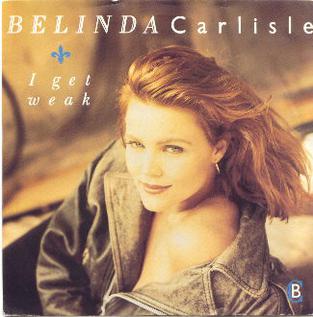
"I Get Weak" is a song by American singer Belinda Carlisle from her second studio album, Heaven on Earth (1987). Written by Diane Warren and produced by Rick Nowels, the song was released as the second single from Heaven on Earth in January 1988. "I Get Weak" reached number two on the US Billboard Hot 100, number four on Canada's RPM 100 Singles chart, and number 10 on the UK Singles Chart.

"Can't Stop Lovin' You" is a song by American band Van Halen. It was released in March 1995 as the third single from their 10th album, Balance (1995). The song emerged after producer Bruce Fairbairn asked for a more pop-oriented song. Instead of searching for his archives, Eddie Van Halen decided to write new music from scratch. The song was written by all members of Van Halen and pays homage to Ray Charles' song "I Can't Stop Loving You", particularly in the line where Sammy Hagar sings "Hey Ray, what you said is true..."
